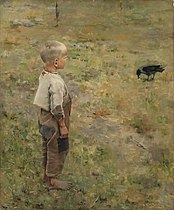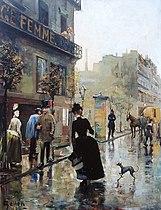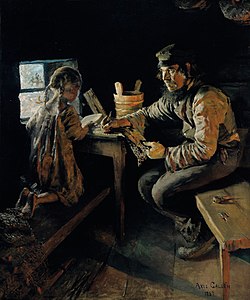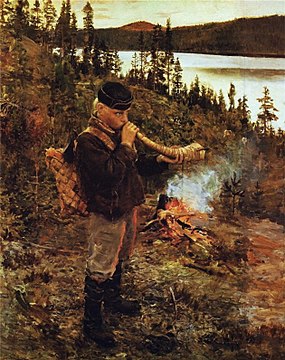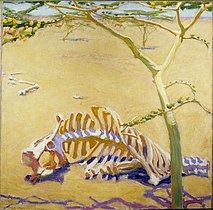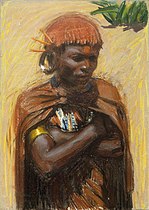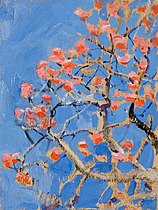Akseli Gallen-Kallela
Finnish painter (1865–1931) From Wikipedia, the free encyclopedia
Akseli Gallen-Kallela (born Axel Waldemar Gallén; 26 April 1865 – 7 March 1931) was a Finnish painter who is best known for his illustrations of the Kalevala, the Finnish national epic. His work is considered a very important aspect of the Finnish national identity. He finnicized his name from Gallén to Gallen-Kallela in 1907.[1]
Akseli Gallen-Kallela | |
|---|---|
 | |
| Born | Axel Waldemar Gallén 26 April 1865 Pori, Grand Duchy of Finland, Russian Empire |
| Died | 7 March 1931 (aged 65) |
| Known for | Painting |
| Movement | Romantic nationalism, Realism, Symbolism |
Life and career
Summarize
Perspective
Early life
Gallen-Kallela was born on 26 April 1865, in Pori, to a Swedish-speaking family. His father Peter Gallén worked as police chief and lawyer.[2] Gallen-Kallela was raised in Tyrvää.[3] At age 11, he was sent to Helsinki to study at a grammar school, because his father opposed his ambition to become a painter. After his father's death in 1879, Gallen-Kallela attended drawing classes at the Finnish Art Society (1881–1884) and studied privately under Adolf von Becker.[1]
Paris

In 1884, he moved to Paris, to study at the Académie Julian.[4] In Paris he became friends with the Finnish painter Albert Edelfelt, the Norwegian painter Carl Dørnberger, and the Swedish writer August Strindberg.[1] During this period he traveled back and forth between Finland and Paris.[1]
Mary Slöör


He married Mary Slöör in 1890. The couple had three children: Impi Marjatta, Kirsti and Jorma. On their honeymoon to East Karelia, Gallen-Kallela started collecting material for his depictions of the Kalevala. His work during this period is characterized by romantic paintings of the Kalevala, such as the Aino Myth, and by several landscape paintings, although by 1894 the influence of symbolism is heavily visible in his works.[1]
- Madonna (Mary and Marjatta), 1891 (fi)
- Shepherd Boy from Paanajärvi, 1892
- Portrait of the Artist's Wife, 1893
- Conceptio Artis, 1894
- Ad Astra, 1894 (fi)
Berlin and tragedy

In December 1894, Gallen-Kallela moved to Berlin to oversee the joint exhibition of his works with the works of Norwegian painter Edvard Munch. At the time Gallen-Kallela also designed a grand cabin called Kalela for his family far from everything on the shore of Lake Ruovesi. It was built from dead standing pine by 13 local carpenters in a year from 1894 to 1895.[11][12]
In March 1895, his trip was ended when he received a telegram that his daughter Impi Marjatta had died from diphtheria, which would prove to be a turning point in his work. Hs works had been romantic, but after his daughter's death, Gallen-Kallela's works became more aggressive. From 1896 to 1899, he painted what are considered his most famous works: The Defense of the Sampo, Lemminkäinen's Mother, Joukahainen's Revenge and Kullervo's Curse.[1] In May 1895, Gallen and Mary visited London, with his intent being the purchase of a graphic art press. There, he also learned about stained glass. At the end of 1897 the family took a trip to Florence, also visiting Pompeii, where he studied the art of frescoes.[1]
- Portrait of Edvard Munch, 1895
- Kalela on a Winter Night, 1896
- The Artist's Mother, 1896
- The Defense of the Sampo, 1896 (fi)
- Lemminkäinen's Mother, 1897
- Joukahainen's Revenge, 1897 (fi)
- The Fratricide, 1897, from Kanteletar
- Mary Sewing on the Veranda of Kalela, 1897
- Kullervo's Curse, 1899 (fi)
- February Vision, 1899
Paris 1900 Exposition
For the Paris World Fair in 1900, Gallen-Kallela painted frescoes for the Finnish Pavilion.[1] In the fresco Ilmarinen Plowing the Field of Vipers there was a hidden political message: one of the vipers is wearing a small Romanov crown,[13] telling of Gallen-Kallela's wish for an independent Finland at the time of the Russification of Finland.
The Paris Exposition secured Gallen-Kallela's stature as the leading Finnish artist.[14] In 1901, he was commissioned to paint the fresco, Kullervo Sets Off for War, for the concert hall of the Helsinki Student's Union.[14] Between 1901 and 1903, he painted the frescoes for the Jusélius Mausoleum in Pori, memorializing the 11-year-old daughter of the industrialist Fritz Arthur Jusélius. (The frescoes however were soon damaged by dampness, and were completely destroyed by fire in December 1931. Jusélius assigned the artist's son Jorma to repaint them from the original sketches.[15] The reconstruction was completed just before Jorma's death in 1939.)[1]
Gallen-Kallela officially finnicized his name to Akseli Gallen-Kallela in 1907.[1] His idea for a 700-page Great Kalevala was fully formed in 1909 with a publication of his plan in the Valvoja magazine.[16]
- Sketch for the 1900 Exposition fresco Ilmarinen Plowing the Field of Vipers, 1899
- Liekki ryijy, designed by Gallen-Kallela
- Spring, c. 1900
[note 4] - Kullervo Sets Off for War, 1901, large mural at Old Student House
- The Theft of the Sampo, 1905 (fi)
- The Departure of Väinämöinen, 1906 (fi)
- The Lair of the Lynx, 1906
- Bil-Bol, Poster for an Automobile Retailer, 1907
Kenya


In 1908, with renewal in mind, Gallen-Kallela and his family moved to Paris. However the city and the new direction art was being taken didn't feel as hospitable as he had hoped, and so in May 1909 they moved much further away to Nairobi in Kenya. He was the first Finnish artist to paint south of the Sahara, and produced over 150 expressionistic works. Although artistically the paintings are of fluctuating quality, their colors and the synergy of the colors are remarkable. They returned to Finland in February 1911.[1] Between 1911 and 1913, he designed and built a studio and house for his family at Tarvaspää, approximately 10 km northwest of the centre of Helsinki.[18]
- The Oceanides, 1909
- Café in Paris, 1909
- Skeleton of a Camel, 1909
- Untitled, 1909
- Kikuyu Woman, 1909
- Portrait of Kenosua, 1909–1910
[note 5] - Rhinoceros and Euphorbia Trees, 1909–1910
- Hippos in the Tana River, 1910
- Homo Victor (Victorious Man), 1910
- Coral Tree in Blossom, 1910
Finnish Civil War


The family moved back from Tarvaspää to Kalela in 1915 to escape the turmoil of the First World War. In 1918, Gallen-Kallela and his son Jorma took part in the fighting at the front of the Finnish Civil War. When the regent, General Mannerheim, heard about that, he invited Gallen-Kallela to design the flags, official decorations and uniforms for the newlyindependent Finland. For the flag, Gallen-Kallela proposed a white-blue cross flag, with colors inverted (white cross on blue), but it was considered too similar to the Swedish flag and particularly the era's Greek flag. In 1919, he was appointed aide-de-camp to Mannerheim.[1] In 1920, he made an agreement with the publishing company WSOY for the eventual publication of Great Kalevala, with the less decorative Koru-Kalevala being published first in 1922.[16]
- Kalela in Autumn, 1915
- The Lovers, 1906–1917
- Portrait of Mary, 1917
- Kirsti Playing the Cello, 1917
- Regretful Kullervo, 1918
- Lemminkäinen by the River of Fire, 1920
Taos, New Mexico, later life, and death

In December 1923, he moved to the United States, where his family followed him in autumn 1924. He first spent time in Chicago, and an exhibition of his work toured several cities.[20] In Chicago, he was impressed by Native American art and moved to Taos, New Mexico, at the art colony there to study it further. During his time in the United States, he began sketching out the Great Kalevala in much more detail. In May 1926, the family returned to Finland. In 1928, together with his son Jormam he painted the Kalevala frescoes at the lobby of the National Museum of Finland. In 1930, he made an agreement to paint a gigantic fresco for the bank Kansallis-Osake-Pankki, but on 7 March 1931, while returning from a lecture in Copenhagen, he suddenly died of pneumonia in Stockholm.[1]
- Indian Chief Clear Water, 1924
- The Indian Sia Ohutaa, 1925
- Our Home in Taos, 1925
- Taos Home in Sunlight, 1925
- Indian on Horseback in Snow, 1925
- Taos, 1925
- Crack Willow and Blue Bird in New Mexico, 1925
- The Great Pike, 1928 fresco based on an earlier a 1904 painting
- Portrait of Carl Gustaf Emil Mannerheim, 1929
- Page depicting the birth of Väinämöinen from the unfinished Great Kalevala, 1920–1930
Legacy
His studio and house at Tarvaspää was opened as the Gallen-Kallela Museum in 1961 and house some of his works and research facilities on him.[21][22]

See also
Notes
- The girl who modeled for the painting was a future parliament member, Maria Raunio.<ref group='' name='FOOTNOTEPohjolainen2016'>Pohjolainen 2016.
- The frames were painted by Elin Danielson-Gambogi.[6]
- Gallen-Kallela was inspired by Sibelius' tone poem En saga (A Fairy Tale). On the right is Sibelius himself, at top left is the visuals it brought to Gallen-Kallela's mind and the empty section at bottom left was supposed to have notes from the tone poem, but Sibelius didn't wish to add them.[9][10]
- There is also a Jusélius Mausoleum fresco called Spring from 1903.
References
External links
Wikiwand - on
Seamless Wikipedia browsing. On steroids.


